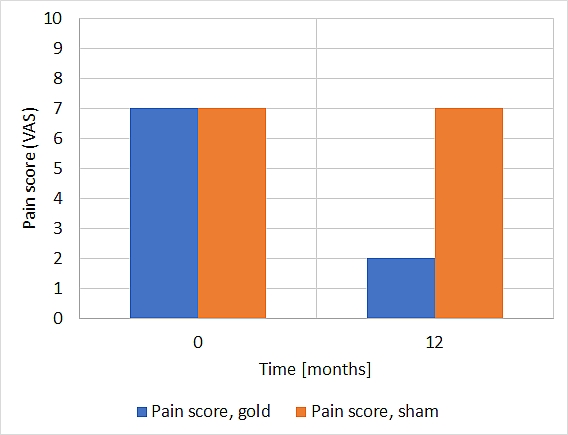Double-Blinded, Placebo-Controlled Trial of the Pain-Relieving Effect of Gold Bead Implantation on Cervical OsteoarthritisThe aim of this randomised, double-blind, placebo-controlled study from 2002 to 2004 was to evaluate the effect of gold-bead implantation on patients with cervical osteoarthritis (OA), as Kjerkegaard explains. “The study was approved by a regional committee on ethics in medical research.” Subsequent to the study, after breaking randomisation, all placebo-treated patients were offered and obtained a gold implantation. The criteria for including patients as participants in the study were: “(1) clinical and radiologically verified cervical OA; (2) age During the second consultation Dr. 2 determined the tender spinal segments and the segmental level or location of gold implantation for patients in the intervention group. The “affected segments at the Hua Tuo points will be tender to deep palpation”. For local anaesthesia, “lidocaine cum adrenalin (10 mg/mL + 5m An envelope, previously selected by the patient and containing the information whether the patient was to receive gold or not, was opened. In case of the “gold” patients, Dr. 3 now implanted three cylindrical beads of 24-carat gold measuring 1mm x 2.5mm and 35mg through each of the needles inserted. He held them in place near the lamina region of the vertebrae by means of an introducer while removing the needle. In case of the “no-gold” patients, “Dr. 3 would feign the procedure of gold implantation”. 24 patients were in the “gold” group, and 22 in the “non-gold” group. The patients were lying face downwards during the procedure. One year after the treatment the same neurologist (Dr. 1), still blinded to the randomization, evaluated the patients’ arthritic neck pain using the VAS scale, and the use of painkillers was registered and its reduction estimated as a percentage. A reduction of at least 30% was regarded as successful by definition. After the final evaluation, the randomisation list was opened. “The results were noted as medians (ranges).” In order to gauge the difference between the treatment groups in the 12-month results, the Mann-Whitney U-test (non-parametric) was used. “The level of statistical significance was p<0,05." In the gold implantation group, the mean VAS score was significantly reduced from 7 (6–9) to 2 (0–9) (p<0,001), in the sham implantation group it remained unchanged at 7. The use of analgesics in the gold implantation group was reduced by
In the discussion Kjerkegaard refers to gold implantation as an experimental area of study in the acupuncture treatment of chronic degenerative diseases. He considers it “remarkable that a one-time implantation of gold beads should have such a sustained pain-relieving effect over so many months”. He points to more than 30 years of application in veterinary medicine and that clinical trials have demonstrated a positive, long-term and sustained palliative effect, while a search in the relevant literature found only one study in human medicine. Kjerkegaard considers it impossible to say whether gold implantation acts as a permanent acupuncture stimulus or via the gold ions that are released into the tissue (according to the study of Danscher in 2002) and absorbed by macrophages, mast cells and fibroblasts. Kjerkegaard regrets that the evaluation took place only after 12 months rather than in between, say every 1 or 2 months, in order to determine when the effect began or had its peak. The 2008 study by Nejrup et al. demonstrated the maximum after 3 months and then no clear trend towards further change. Kjerkegaard remarks that in his study “no patients developed inflammations, rejection or discomfort related to the implanted gold”. Years after the gold implantation, Y-ray images showed that the implants were still at the same location. He concludes: “The present study revealed that the pain-relieving effects of extra-articular gold bead implantation is a promising treatment modality with long-term effects for patients with cervical OA. The gold implantation procedure requires extensive experience with special acupuncture techniques and needs to be done with the same accuracy as any other surgical treatment.”
|


